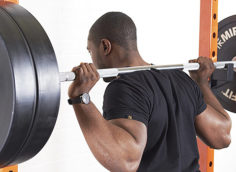Here's what you need to know...
- Mental toughness can be built. Forcing yourself to do a painful workout like "9 Minutes of Squatting Hell" is one way.
- Consistency is key. Focus on getting strong at a few important exercises.
- Be competitive. Get mad when you miss a lift, and resolve to come back stronger.
- Identify your weaknesses and find the answers. Only wimps stop learning.
Champions share four mental traits. They're tough, consistent, competitive, and resolute. Here's how you can rise to their level.
1 – Tough
Some emerge from the womb ready for a fight. These people are easy to spot – they flinch the least when they hurt the most, and they'd rather collapse trying than lose face by quitting. These people are capable of incredible things when they channel their grit into their passions.
How do you develop champion-level toughness? By rising to challenges and completing them.
- Problem: You give up too easily and shy away from painful, difficult endeavors.
- Solution: Once a week, devise a workout that's specifically designed to be miserable. Force yourself through it.
A good trainer can force anyone through a gauntlet of hell. They'll either quit or come out hardened. But if you're on your own, you need to take extra steps and program some misery into your weekly routine. Here are some examples:
The Horrible Hundred
The rules here are simple. Take the number of continuous push-ups you can do in a set before failing and multiply this by 2.5.
Now, complete this number without allowing the knees to touch the floor. You can hold plank or pike to the down-dog position for rest, but that's it.
I've only had ten athletes out of 100+ complete this test. It's 95% mental.
Hypoxia Hell
The best way to both increase suffering and increase conditioning at the same time is by stealing the athlete's precious air. We've all watched a fish flop around out of water – shortened rest intervals will achieve a similar level of hypoxia and remind you how delicious air is. Here are three examples:
Do 8 For 15
My personal favorite for this classic challenge is the back squat. Grab an 8-rep weight and don't rack the bar until you've finished 15 reps. "Rest" only by standing there with the bar on your back and sucking wind until you can do another rep.
Make sure you're a strong squatter before trying this, though, as mediocre form at the start will quickly turn to dangerous form by the end.
Just one or two sets of this is plenty. You can use any compound exercise, but only go to the limits of good form.
The 3-2-1 Back Squats: 9 Minutes of Hell
This is one of my favorite workouts for a quick in-and-out when pressed for time. Use a light weight and move fast: 35-50% 1RM is fine.
- 3 minutes: As many reps as possible without racking the bar.
- 2 minutes: Rest
- 2 minutes: As many reps as possible without racking the bar.
- 1 minute: Rest
- 1 minute: As many reps as possible without racking the bar.
Pushup & Plate-Push Repeaters
Metabolic finisher complexes are a great way to burn fat, increase conditioning, and remind yourself that you're not a pansy. Here's an example:
The work: Sets of 20 push-ups, followed by a 20-yard plate-push. (Just push a 45-pound weight plate across the floor.)

2 – Consistent
The biggest reason people fail to reach levels of elite skill and strength is that they're not consistent enough in their routine. They want a new program every month, a new exercise every workout, and have a new goal every time you see them.
Whatever the task is, the simplest drills and exercises that most closely mirror the goal are the ones that need to be paid lifelong attention. Elite skill will emerge when these select few exercises are refined and repeated thousands of times.
- Problem: You switch things up too often and can't stay in a routine.
- Solution: Identify three compound exercises that are integral to your goal. Keep them in your program for 16 straight weeks. Focus on the horizon.
If you want to increase your squat, you need to squat. If you want bigger shoulders, you need to press overhead. If you want bigger arms, you need to do chin-ups. If you want a better butt, you need to do hip thrusts. If you want to cut fat, you need do all the above with little rest.
It doesn't matter who you are, the big lifts – the above plus deadlifts, Romanian deadlifts, push-ups, bench presses, barbell rows, farmers walks, and good mornings – are applicable and will always have a place in your routine.
I don't care how bored you are, it's not about keeping you entertained; it's about results. Force yourself to be consistent with key lifts – change the reps, change the tempo, change the resistance. Just stop catering to your infantile attention span. Give it 16 weeks and see how you feel thereafter.
3 – Competitive
The biggest set of balls in my gym belongs to a kid who still can't squat his bodyweight. One day as a warm-up, I decided to have a plank contest with 12 teenaged athletes.
The winner was a 115-pound 13-year old. As everyone else gave up and put their knees down, Jake stared at the floor. The kid had no business winning that contest – he was the twelfth strongest in the group – but he absolutely refused to touch that floor.
After 8 minutes, he was the last man planking and won the "Badass of the Month" award. Literally every day on every set, PR or not, he asks if his form is good enough to add weight to his exercise.
Do you have that attitude? If you don't, one day that kid will be bigger, faster, and stronger than you.
- Problem: You admit defeat and think nothing of it.
- Solution: Grow a pair. Compete with the bar and don't let inanimate objects beat you.
Toughness differs from competitiveness. Competition is an internal drive to win, toughness is the internal discipline to not quit. The solution to a lack of competition goes back to bullet #1 – find something you may not be able to do, and do it.
Too many people are scared of pain and failure and don't know how to compete. The best lifters I've ever met are also the most competitive with the iron – they refuse to be beaten by it and don't accept defeat by an exercise or a weight.
If the bar staples you, don't shrug your shoulders and move on. Feel slighted. Feel embarrassed. Feel beaten. It may not be appropriate to jump back under and hurt yourself trying, but if you don't feel the sting of defeat, you're probably better served by the elliptical.

4 – Resolute
Resolute is defined as admirably purposeful, determined, and unwavering. This is one of my favorite words, and it's reserved for only a select few. Those who are resolute continue to get back up after defeats in search of new ways to conquer their goals.
For the T-Nation reader, it means being informed – seeking advice and being open-minded toward new training methods. Too many read good advice only to ignore and continue failing.
- Problem: Things get tough and goals aren't met.
- Solution: Comb through your program and pick out deficiencies.
If you have a serious goal, one for which you're willing to suffer and devote your life, you'd be an idiot to go in uninformed. Even the best, most genetically gifted will hit plateaus and find themselves destitute, in search of a solution.
Fortunately, there's always a solution for those who look hard enough and are willing to keep grinding. What separates champions from the rest is their approach to failure – champions scour the globe for answers; they don't simply accept defeat. A simple approach is to inspect ones program according to the following criteria:
Speculate on the three simplest reasons for failure
Chances are, you didn't fail to meet a training goal because your percentages or methods were slightly off. Rather, it was probably something glaring – calories, volume, exercise selection, etc.
You probably wasted time doing things that were less goal-centric and omitted obviously better (in hindsight) choices. You get stapled forward on heavy squats? Well, are you doing good mornings? You'd be surprised how often the answer is "no."
Find one or two simple ways to boost each weakness
Not getting enough calories? Okay, why? Are you skipping meals, too busy to prepare ahead? Set aside a cooking day and buy some Tupperware.
Failing to make it through workouts or can't recover? How's your pre- and peri-workout nutrition? A supplement protocol could make all the difference.
Failing to lock out your deadlifts? Okay, how strong are your glutes? How often are you doing hip thrusts?
Don't overhaul everything. Just search for a few glaring deficiencies and make some sensible adjustments.
Continue To Reassess
So you audited your life and made some changes. How did they work? Were goals met? If not, what's left to improve upon?
Those who are resolute refuse to accept that they did all they could and still failed. The reality is that there's always a solution. Most times, however, we simply ignore the solution because it's too long and too painful to endure. To that, I recommend reviewing points 1, 2, and 3.
Get After It!
Mental strength is a stiff cocktail, for which few have the stones or the stomach. A combination of toughness, hyperopic vision, consistency, competitiveness, and resolve will take any person from chump to champion.





